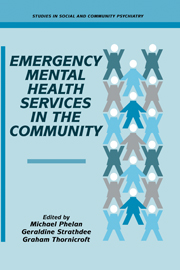Book contents
- Frontmatter
- Contents
- Contributors
- Foreword
- PRINCIPLES AND POLICIES
- CHALLENGE OF IMPLEMENTATION
- 9 Establishing a local emergency service
- 10 Maintaining an emergency service
- 11 Psychiatric emergencies in the casualty department
- 12 Acute crisis respite care
- 13 Family placement schemes as an alternative to short-term hospitalisation
- 14 Acute home-based care and community psychiatry
- 15 Acute day hospital care
- 16 Acute in-patient wards
- 17 The future of mental health emergency services
- Index
13 - Family placement schemes as an alternative to short-term hospitalisation
from CHALLENGE OF IMPLEMENTATION
Published online by Cambridge University Press: 28 October 2009
- Frontmatter
- Contents
- Contributors
- Foreword
- PRINCIPLES AND POLICIES
- CHALLENGE OF IMPLEMENTATION
- 9 Establishing a local emergency service
- 10 Maintaining an emergency service
- 11 Psychiatric emergencies in the casualty department
- 12 Acute crisis respite care
- 13 Family placement schemes as an alternative to short-term hospitalisation
- 14 Acute home-based care and community psychiatry
- 15 Acute day hospital care
- 16 Acute in-patient wards
- 17 The future of mental health emergency services
- Index
Summary
I really liked the Crisis Home. Staying with a regular family kept me from feeling abnormal, and helped me feel like a regular person.
‘Mary’Introduction
For thousands of years people in crisis have found support by staying with concerned and caring neighbours. This was achieved without staff, formal programmes, quarterly fiscal reviews or programme criteria; help was needed, help was offered. It is therefore logical that community families are a component of contemporary community mental health care, yet this type of service is rarely found in mental health systems.
This chapter will explore the role of community families in providing emergency support to people with mental illness. After some background and a review of the literature, the Crisis Home Program of the Mental Health Center of the Dane County will be described in detail, with an emphasis on practical considerations. The chapter will conclude with observations about why this option is not more prevalent despite its tremendous potential.
Historical overview and review of literature
The ‘innovative’ ideas of the current age are often the direct descendants (and bear a striking resemblance) to notions of previous generations. This is certainly the case with the idea of using family homes to help those with a mental illness. The most famous example is that of the village of Gheel, Belgium, where for perhaps 1300 years families have opened their homes to people with mental illness (Aring, 1974). This was most commonly done on a long-term basis.
- Type
- Chapter
- Information
- Emergency Mental Health Services in the Community , pp. 259 - 275Publisher: Cambridge University PressPrint publication year: 1995
- 3
- Cited by

